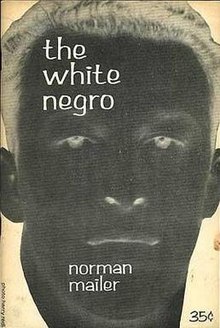White Negro

(publ. City Lights)
|
|
| Author | Norman Mailer |
|---|---|
| Country | USA |
| Language | English |
| Genre | Essay |
| Publisher | City Lights |
|
Publication date
|
1957 |
| Media type | |
The White Negro: Superficial Reflections on the Hipster, a 9,000-word essay by Norman Mailer, connects the "psychic havoc" wrought by holocaust and the atomic bomb to the aftermath of slavery in America in the figuration of the Hipster, or the "white negro". It is a call to disassociate from Eisenhower liberalism and a numbing culture of conformity and psychoanalysis to embrace a rebellious, personal violence and emancipating sexuality that Mailer associates with marginalized black culture. The essay was first published in the 1957 special issue of Dissent, before being published separately by City Lights. While Mailer's essay was controversial upon its release, winning praise, for example, from Eldridge Cleaver and equal criticism from James Baldwin, it remains perhaps his most famous and reprinted essay and "established Mailer's reputation as a philosopher of hip".
The origins of The White Negro (WN) date from the mid-1950s. Louis Menand, in his history of The Village Voice directly links Mailer's 17-article column "Quickly: A Column for Slow Readers" to Mailer's development of his philosophy of hip, or "American existentialism".
"Lipton's Journal", Mailer's unpublished 105,000-word diary of self-analysis written over four months while smoking marijuana, also figures into the essay's genesis. It documents "his insights [that] challenge some of the dominant ideas of Western thought", specifically the dualisms that Mailer saw within every individual, like the saint and the psychopath. Mailer had planned to use the insights from Lipton's in a series of novels which never happened, but he did incorporate some of the journal's ideas into WN. He sums these up in one of the last entries in Lipton's:
Generally speaking we have come to the point in history—in this country anyway—where the middle class and upper middle class is composed primarily of the neurotic-conformists, and the saint-psychos are found in some of the activities of the workingclass (as opposed to the workingclass itself), in the Negro people, in Bohemians, in the illiterates, among the reactionaries, a few of the radicals, some of the prison population, and of course in the mass communication media.
...
Wikipedia
